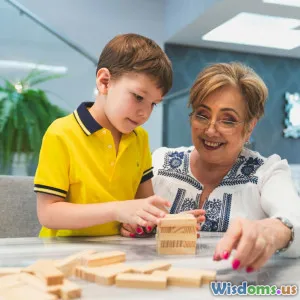
How Technology Is Changing Family Communication Patterns
11 min read Explore how technology reshapes family communication, transforming connections, challenges, and opportunities in the digital age. (0 Reviews)
How Technology Is Changing Family Communication Patterns
Introduction
In today’s digitally driven world, the landscape of family communication is undergoing an extraordinary transformation. As smartphones, social media, and instant messaging apps saturate daily life, traditional methods of interaction are increasingly interwoven with digital connections. This fusion invites both opportunities and challenges, reshaping how families nurture relationships, maintain closeness, and navigate misunderstandings.
Did you ever pause to consider how your last Sunday dinner conversation might have differed if smartphones weren’t at hand? Or how video calls bridge miles across continents, keeping grandparents connected with grandchildren they rarely see in person? The way technology changes family dialogue impacts emotional bonds, conflict resolution, and cultural transmission, affirming how indispensable digital tools have become in the family ecosystem.
This article explores how technology reshapes communication among family members, influences intergenerational dialogue, and redefines togetherness in the era of ubiquitous connectivity.
The Evolution of Family Communication: From Hearth to Hashtags
Traditional Communication: The Foundation
Historically, families gathered around firesides or dinner tables to share stories, advice, and emotions. Face-to-face interaction meant eye contact, voice tone nuances, and physical gestures — all integral parts of conveying empathy and understanding. Such synchronous communication fostered intimate bonds and created a natural rhythm of family life.
Enter Technology: Accelerating and Multiplying Connections
With the advent of telephones in the early 20th century, families could stay connected across distances but still relied primarily on voice. The explosion of the internet and mobile devices in the 21st century revolutionized this dynamic. Communication became not only audio but text-based, visual, asynchronous, and instantaneous.
Apps like WhatsApp, FaceTime, and Zoom enable group chats, video calls, and multimedia sharing, making family interaction less limited by geography or time zones. According to a 2022 Pew Research Center report, 85% of adults with family living apart use technology regularly to communicate, a figure that climbs to 95% among those aged 18-29.
Technology not only speeds communication but also diversifies modes—memes, emojis, GIFs, and voice notes become new languages within the familial dialogue.
Positive Transformations: How Technology Strengthens Families
Bridging Physical Distances
One of the most celebrated impacts of technology is its ability to close physical gaps. Military families, migrant workers, and expatriates leverage video calls to participate in birthday celebrations, school events, or even just daily check-ins. For example, a study by the University of Texas found that video calls enhance feelings of presence and emotional connection when family members live apart.
Video conferencing tools also offer visually rich engagement, allowing expressions, home tours, and body language to supplement verbal communication—essentially creating "virtual presence."
Building New Rituals and Sharing Moments
Technology allows families to create digital rituals, such as a shared photo album app or coordinated movie nights via streaming platforms. These innovations foster shared experiences despite physical separation.
Similarly, family WhatsApp or Messenger groups provide real-time updates, plans, and humor—maintaining an ongoing dialogue that weaves family members' daily lives closer.
Facilitating Intergenerational Communication
Modern tools help bridge generational gaps. Grandchildren teaching grandparents how to use tablets, parents joining their kids in gaming sessions on platforms like Fortnite, or families collaborating on digital storytelling projects connect generations in new, meaningful ways.
Multi-generational households report increased harmony when digital literacy is shared, transforming technology from a divider into a unifier.
Challenges and Shifts: Navigating Complex Communication Dynamics
Fragmentation and Attention Distraction
Ironically, while technology offers more modes to connect, it can also fragment attention and reduce the quality of interactions. Devices competing for attention during family dinner or important discussions leads to digital distractions described as "technoference."
A 2019 study published in the Journal of Social and Personal Relationships found that increased phone interruptions correlate with lower relationship satisfaction and communication quality among families.
Surfacing Conflicts Over Digital Boundaries
Disagreements over phone usage, screen time for children, and privacy settings signal new fronts of familial negotiation. Some parents struggle with balancing their children’s online exposure with real-world responsibilities.
Additionally, differing preferences for digital communication can cause friction, such as when older adults prefer phone calls over texting or younger members favor quick emojis over extended conversations.
Digital Miscommunication and Emotional Nuance
Text-based messages might lack voice tone or facial cues, heightening misunderstanding risks. Misinterpretation of emojis or sarcasm can inflame family disputes unintentionally.
Dr. Shira Gabriel, a social psychologist, states that "digital messages often require 'emotional labor' to clarify intent," placing a new communication burden on family members.
Case Studies of Technology Impact in Families
The Millennial Family: Blending Old and New
Consider a household where parents aged 40-50 use traditional voice calls, while their 15-year-olds prefer Snapchat and TikTok for exchanges. The parents learn about their children’s interests through shared content rather than direct conversation, sparking fresh dialogue and occasionally, generational slang confusion.
Nevertheless, collaborative tech tools like shared digital calendars help synchronize family schedules efficiently, illustrating technology’s pragmatic role.
Migrant Families: Preserving Ties Across Continents
Immigrant families rely heavily on apps like WhatsApp or WeChat to maintain a dialog with relatives back home. Daily text messages, call check-ins, and video-enabled role calls support emotional well-being, reducing feelings of isolation.
A relevant example is the Filipinx diaspora, where over 90% of overseas workers use social media and messaging apps to stay connected with family, blending cultural retention with modern communication.
Families During the Pandemic: Technology as a Lifeline
During COVID-19 lockdowns, families widely adopted video calls and online group events to cope with social isolation. Platforms like Zoom became virtual living rooms, with multi-generations attending virtual birthdays, holidays, and even baby showers.
The increase in digital communication during 2020 provides generational awareness about the utility of technology in maintaining family cohesion during crisis.
Strategies to Foster Healthy Family Communication Amid Technology Usage
Establishing Device-Free Zones and Times
Encouraging device-free family meals or a weekly “tech0 hour” helps focus on face-to-face dialogue. Family members can reconnect through storytelling, games, or simply attentive listening that technology sometimes eclipses.
Promoting Digital Literacy for All Ages
Workshops or informal sessions teaching older members basic smartphone functions or social media safety empower them to participate confidently. Likewise, educating younger members on digital etiquette and emotional interpretation fosters responsible use.
Intentional Use of Technology for Quality Interaction
Instead of defaulting to texting, family members can schedule video chats to ensure richer emotional exchanges. Sharing photos or recorded messages creates cherished archives of family history and memory.
Furthermore, transparent discussions about online boundaries, privacy, and respectful communication set a foundation for minimizing misunderstandings.
Balancing Online and Offline Communication
Healthy families cultivate a hybrid model—leveraging technology’s convenience while preserving traditional, physical interactions whenever possible.
Parents can model this balance, such as turning devices off during meaningful conversations and encouraging outdoor or creative group activities.
Conclusion
Technology is indisputably reshaping how families communicate. It acts as both a bridge and a barrier — extending connections across distances and time zones, while also introducing challenges like distracted attention and new sources of conflict.
Understanding these shifting dynamics equips families to harness technology positively, fostering deeper connections, shared experiences, and intergenerational understanding. The key lies not in rejecting technology but embracing it mindfully.
By establishing thoughtful habits, promoting digital literacy, and continuing to value face-to-face interaction, families can navigate the complexities of this digital age.
In the end, technology should serve as a tool to enrich family life — maintaining warmth and closeness, no matter how much the modes of communication evolve.
References
- Pew Research Center. (2022). "Family Communication in the Digital Age." https://www.pewresearch.org/
- University of Texas Study on Video Calls and Emotional Connection, 2021
- Journal of Social and Personal Relationships, "Technoference and Relationship Quality," 2019
- Gabriel, S. (2020). Communication and Emotional Labor Online, Psychology Today
- Filipinx Immigrant Family Communication Report, 2023
Rate the Post
User Reviews
Popular Posts



















